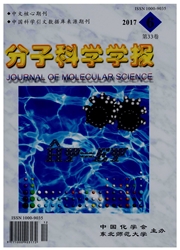

 中文摘要:
中文摘要:
采用密度泛函理论(DFT)方法,并结合导体极化连续模型(CPCM)研究了[(N-EtIm)H][trans-Ru^ⅢCl4(DMSO)(N-EtIm)](N-EtIm=N-乙基咪唑)分别在中性及酸性条件下的水解反应过程.同时,为提高溶剂化能的精确度,在中性条件下水解反应的计算中采用3个水分子的溶剂化模型.计算得到水解反应过程中相应的结构特征和详细的热力学能量及速率常数.首先,在中性条件下,对于第一步水解,液相中配合物的活化能垒为109.9kJ/mol,速率常数为3.3×10-7 s-1,与实验中测得的第一步水解反应的速率常数(4.4×10-7 s-1)一致.对于第二步水解,反应的活化能垒为117.9kJ/mol,这符合实验中观察到的第二步水解比第一步水解反应慢的现象.其次,计算结果表明,酸性条件下,DMSO基团易于水解,Cl-水解困难,这也与实验结果相吻合.
 英文摘要:
英文摘要:
The hydrolysis process in neutral and acidic conditions of a Ru( III ) complex [-(N-Etlm)H] [trans Ruul C14 (DMSO)(N-EtIm)],was investigated by using density functional theory (DFT) method combing with the conductor-like polarizable calculation model (CPCM). In order to improve the sol vation energies,three explicit water molecules were included in calculations on the hydrolysis process in neutral conditions. The structural characteristics and the detailed energy profiles as well as the rate constants (k) for the hydrolysis processes of this complex were obtained. Firstly, in neutral conditions,for the first hydrolysis step,the computed relative free energy △G° (aq) and rate constant (k) in aqueous solution are 109.9 kJ · mol 1 and 3.3 × 10.7 s-1 , respectively,very similar to the rate constant of 4.4 × 10 7 s-1 determined on experiment. For the second hydrolysis step,the calculated relative free energy △G° (aq) in aqueous solution is 117.9 kJ · mol 1 ,the value that is in accordance with the experimental evidence indicating a slower rate for the second aquation. Secondly,it is found that the hydrolysis of DMSO ligand (path 2) in acidic solution has thermodynamic preference over the hydrolysis of Cl atom (path 1) ,again in good agreement with experimental one.
 同期刊论文项目
同期刊论文项目
 同项目期刊论文
同项目期刊论文
 Hydrolysis Mechanism of the NAMI-A-type Antitumor Complex (HL)[trans-RuCl4L(dmso-S)] (L=1-methyl-1,2
Hydrolysis Mechanism of the NAMI-A-type Antitumor Complex (HL)[trans-RuCl4L(dmso-S)] (L=1-methyl-1,2 期刊信息
期刊信息
